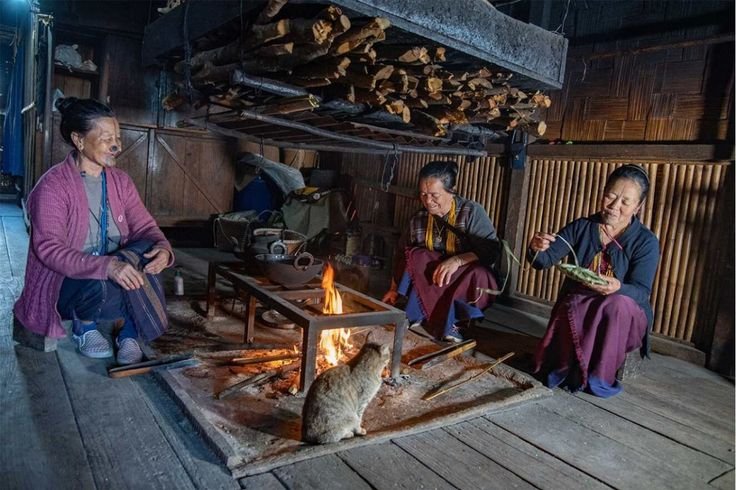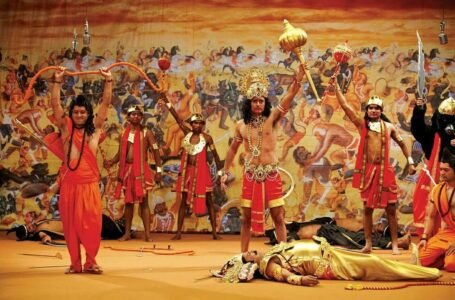The Endangered Melodies: Folk Songs of the Apatani Tribe in Arunachal Pradesh

Nestled in the picturesque valleys of Arunachal Pradesh, the Apatani tribe is renowned for its unique cultural heritage, which includes distinct practices, art, and oral traditions. Among their many treasures, the folk songs of the Apatani people stand as a vibrant testament to their rich history and enduring connection to nature. These songs, with their soulful melodies and meaningful lyrics, have served as a vital medium for passing down stories, values, and traditions through generations. However, in the face of modernization and changing lifestyles, this cultural gem is now at risk of fading into oblivion.
The Apatani tribe resides in the Ziro Valley, a UNESCO World Heritage Site celebrated for its serene landscapes and sustainable agricultural practices. Within this environment, the Apatani people have developed an oral tradition that reflects their harmonious relationship with nature. Their folk songs, traditionally sung during festivals, rituals, and everyday activities, embody their deep respect for the land, water, and forests that sustain their way of life. Themes of gratitude, community, and spirituality dominate these songs, making them not just a form of entertainment but also a repository of wisdom and identity.
Apatani folk songs often accompany key cultural events, such as the Dree and Myoko festivals, which are central to their agricultural and social calendars. During these festivals, the songs celebrate the cyclical nature of life, the fertility of the earth, and the interconnectedness of all living beings. For instance, songs dedicated to the Dree festival express gratitude to the deities for protecting their crops and ensuring a bountiful harvest. Similarly, songs sung during the Myoko festival strengthen bonds of friendship and unity among the Apatani clans.
These folk songs are rich in metaphor and imagery, drawing inspiration from the natural beauty of Ziro Valley. The lyrics often personify rivers, mountains, and trees, attributing divine qualities to them and emphasizing the importance of living in harmony with the environment. The melodies, though simple, carry profound emotional weight, resonating deeply with the listeners. The oral nature of these songs also ensures that they evolve organically, adapting to the times while preserving their essence.
However, the rise of modern influences poses a significant threat to the survival of Apatani folk songs. With the younger generation increasingly adopting urban lifestyles and Western music, the traditional songs are gradually losing their relevance. The decline of oral transmission, which has been the primary mode of preserving these songs, further exacerbates the issue. As elders pass away without passing down their knowledge, a vital link to the tribe’s heritage is being severed.
Efforts are underway to document and revive the Apatani folk songs, but challenges remain. The task of accurately recording the nuances of oral traditions is complex, requiring the collaboration of linguists, ethnomusicologists, and community members. Moreover, there is a pressing need to raise awareness about the cultural significance of these songs, both within the Apatani community and beyond. Encouraging younger generations to engage with their heritage through school programs, cultural festivals, and digital media can play a crucial role in preserving this art form.
The folk songs of the Apatani tribe are more than mere melodies; they are a vital part of the tribe’s identity and a testament to their deep connection with nature. As custodians of this rich heritage, the Apatani people must be supported in their efforts to safeguard their songs for future generations. By recognizing the value of these cultural gems and taking proactive steps to preserve them, we can ensure that the harmonious spirit of the Apatani tribe continues to resonate in the valleys of Arunachal Pradesh for years to come.
The Apatani tribe maintains a cultural backbone and advanced sustainable farming approaches while relating strongly with nature through its secluded foothills inside Arunachal Pradesh. Folk songs embody the cultural essence of the Apatani because they generate musical appreciations that honor their relationship with their nature as well as their accumulated traditions. For many years these musical expressions moved throughout Ziro Valley’s lush landscapes yet today they face extinction. Modernization together with changing lifestyles and declining interest of the younger generation puts this essential component of Apatani culture at risk of permanent disappearance. This blog examines why Apatani folk songs matter while highlighting their cultural purpose together with why they are fading away and stressing the importance of their protection.
Pieces of Apatani music represent ancient tribal historical records which function as repositories for essential cultural techniques and wisdom traditions. Through Apatani songs a Tribe shows its natural harmony while depicting traditional beliefs that connect the people directly with nature. Through successive generations these melodies become part of Apatani life as they create emotional harmony during major ceremonies, ritual functions and everyday tasks.
These musical compositions share stories about origin narratives and family history and natural wonders. Through their musical traditions they honor gods while thanking deities for successful farm productions and praying for comfort during times of sadness. At the Apatani Myoko festival which celebrates both friendship and prosperity the community uses folk songs to receive blessings from gods as well as to foster stronger communal relationships.
The Connection Between Songs and Nature
Nature and the culture of the Apatani folk hold deep inseparable connections through their traditional songs. The Ziro Valley maintains its dual role of both creative spring and listening venue through its lush green rice fields and charismatic mountainscape. Through their songs the Apatani community praises both the scenic beauty of their surroundings and the production cycles of harvests and their unions with nature.The musical rites maintain religious purpose because performers provide songs to nature beings throughout spiritual ceremonies which protect ecosystem stability. Music for the Apatani community pengroups the worship of solar (Donyi) and lunar (Polo) elements into its foundation. Through their musical content these artistic expressions become vital instruments both in warning people about environmental dangers and protecting the environment.
The Threat of Modernization
Various major trends have affected the Apatani tribe during recent decades because of modernization together with urbanization and globalization processes. Their lifestyle changes due to modern developments substantially influenced how they practice their folk traditions. Young individuals today gain their influence from advanced education together with technological advancements that lead them away from traditional customs. The attraction of present-day pop entertainment and contemporary music has pushed folk songs into gradual extinction because young Apatani do not perform them anymore and lose their traditional art forms.
Unfortunately the absence of official documentation creates major obstacles for preservation of these musical works. The oral transmission method of this knowledge disappears when key elderly figures who knew these traditions pass away. The future survival of this tradition faces a serious threat because traditional singing events have decreased along with student interest.
Importance and Unique Features of Apatani Folk Songs
The folk songs of the Apatani tribe are not just artistic expressions but an essential part of their social, cultural, and spiritual fabric. Rooted in the traditions of the Ziro Valley, these songs serve as a living archive of the tribe’s beliefs, history, and values. They offer a unique window into the Apatani way of life, which is marked by a deep reverence for nature, strong community bonds, and a sustainable approach to living. Understanding the importance of these songs involves appreciating the roles they play in various aspects of Apatani culture, from rituals to education, and their connection to the broader environmental and cultural context of Arunachal Pradesh.
One of the most significant aspects of Apatani folk songs is their role in rituals and festivals. Festivals such as Dree and Myoko are incomplete without these songs, as they are integral to the performance of rituals and the invocation of deities. During the Dree festival, which is celebrated to ensure agricultural prosperity and protect crops from pests and diseases, the songs are offerings of gratitude to the gods, particularly Tamu, Harniang, and Danyi-Piilo. These songs are carefully composed to align with the themes of fertility, growth, and protection. Similarly, during the Myoko festival, which is a celebration of friendship, kinship, and social unity, the songs reflect themes of togetherness and shared responsibilities, underscoring the community-centric values of the Apatani people.
Another remarkable feature of Apatani folk songs is their connection to oral storytelling. These songs are a primary medium through which myths, legends, and historical accounts are preserved and passed down through generations. For example, the songs recount tales of origin, tracing the lineage of the Apatani people and their connection to the land. These narratives not only strengthen their identity but also instill a sense of pride in their heritage. The oral tradition of singing ensures that these stories are kept alive, albeit with variations that reflect the dynamism of the Apatani culture.
The environmental significance of these songs cannot be overstated. Living in the ecologically sensitive Ziro Valley, the Apatani people have developed a sustainable way of life that includes wet-rice cultivation and fish farming. Their songs often celebrate the interconnectedness of natural elements, such as rivers, forests, and mountains, portraying them as sacred entities. This perspective fosters a sense of stewardship toward the environment, which has been critical to preserving the ecological balance of the valley. For instance, some songs emphasize the importance of water conservation and the protection of sacred groves, reflecting an environmental ethos that modern societies can learn from.
In addition to their cultural and environmental significance, Apatani folk songs are a medium for imparting wisdom and life lessons. Elders use these songs to teach younger generations about moral values, ethical behavior, and traditional practices. The melodies are simple but powerful, making them easy to remember and emotionally resonant. This educational aspect of the songs ensures that even as formal education becomes widespread, the Apatani youth remain rooted in their cultural values.
However, the uniqueness of Apatani folk songs extends beyond their themes and content. The style of singing itself is distinct, characterized by melodic patterns that are deeply evocative. Unlike many contemporary music forms, these songs rely heavily on the human voice, often accompanied by simple instruments or performed a cappella. The communal nature of singing—where groups of people come together to perform—reinforces social bonds and creates a shared emotional experience.
Despite their importance, Apatani folk songs are increasingly under threat due to the forces of modernization, urbanization, and cultural homogenization. Younger generations are often more drawn to mainstream music and digital entertainment, leading to a gradual decline in the practice and transmission of these songs. Furthermore, the lack of written records and systematic documentation adds to the vulnerability of this tradition. If immediate steps are not taken to preserve and promote these songs, an invaluable cultural asset could be lost forever.
Efforts to revive and protect Apatani folk songs are gaining momentum. Scholars, anthropologists, and local community leaders are working together to record and archive these songs, ensuring their survival for future generations. Educational initiatives, such as introducing Apatani music into school curriculums, are also being explored. Additionally, cultural festivals and performances that showcase these songs to a broader audience can help raise awareness about their importance. By leveraging modern tools, such as digital platforms and social media, the Apatani people can bring their folk songs to global attention while ensuring their preservation.
In summary, the folk songs of the Apatani tribe are a treasure trove of cultural, environmental, and historical knowledge. They embody the essence of the tribe’s harmonious existence with nature and their commitment to community values. Preserving these songs is not just about saving a musical tradition; it is about safeguarding a way of life that offers valuable lessons for the modern world. Through collective efforts, these songs can continue to echo across the Ziro Valley, reminding us of the beauty and wisdom inherent in indigenous cultures.
Efforts to Preserve Apatani Folk Songs
Efforts to save Apatani tribe folk songs continue despite ongoing difficulties. Several local community organizations unite with cultural activists to research and properly educate the millennial generation about preserving folk songs. Traditional music from Ziro Festival of Music takes place together with modern music genres allowing both traditional and contemporary musical compositions to coexist in the festival lineup.Government agencies along with non-profit organizations back these cultural preservation efforts through tourism development strategies and they run traditional art workshops. School curriculum integration of folk music combined with community-supported intergenerational exchange will help protect this cultural heritage. Through digital platforms listeners can access and globally share the traditional songs.
Why Preservation Matters?
Preserving Apatani folk songs represents both the protection of music artistry and the defense of traditional life practices and tribal knowing. Through their musical composition the songs reveal guidance about sustainable living, community bonds with each other and deep spiritual ties to nature. The Apatani cultural essence faces extinction if these traditional songs disappear from existence. Such loss would impoverish human cultural heritage.These songs maintain ongoing inspirational power to create modern environmental activism. Modern societies can discover vital ecological lessons through the Apatani approach to using music as a practice for honoring and sustaining nature.
Through their folk songs the Apatani tribe showcases their cultural traditions alongside their core values and historical narrative. The important call for community collaboration arises to protect these precious melodies from destruction because modernization creates an urgent risk to their preservation. The preservation of Apatani music depends on documentation anddistribution as well as public awareness so their traditional musical heritage will echo throughout periods and territories.
Ziro Valley’s tunes need to be cherished through the present while they should be shared throughout future generations. These songs preserve a tribute to human tradition alongside their role as tribal music expressions. Together we must work to preserve Apatani folk songs because variations and traditional musical textures offer both history and profound wisdom for our present time.


